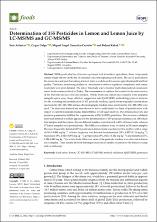| dc.contributor.author | Aslantaş, Şule | |
| dc.contributor.author | Gölge, Özgür | |
| dc.contributor.author | González-Curbelo, Miguel Ángel | |
| dc.contributor.author | Kabak, Bülent | |
| dc.date.accessioned | 2023-05-30T08:37:17Z | |
| dc.date.available | 2023-05-30T08:37:17Z | |
| dc.date.issued | 2023 | en_US |
| dc.identifier.citation | Aslantas, S., Golge, O., González-Curbelo, M.Á., Kabak, B. Determination of 355 Pesticides in Lemon and Lemon Juice by LC-MS/MS and GC-MS/MS. Foods.12 (9), 1812. | en_US |
| dc.identifier.issn | 23048158 | |
| dc.identifier.uri | https://doi.org/ 10.3390/foods12091812 | |
| dc.identifier.uri | https://hdl.handle.net/11491/8476 | |
| dc.description.abstract | Abstract: While pesticides have become a primary tool in modern agriculture, these compounds remain a high priority on the list of consumer concerns regarding food safety. The use of pesticides in the production and post-harvesting of lemon fruits is widely used to ensure agricultural yield and fruit quality. Therefore, monitoring studies on citrus fruits to enforce regulatory compliance and ensure food safety is in great demand. The aim of this study was to monitor multi-class pesticide residues in lemon fruits commercialized in Turkey. The transmission of residues that existed on the outer surface of the fruit into its juice was also studied. Whole fruits and lemon juice samples were prepared using the quick, easy, cheap, effective, rugged and safe (QuEChERS) methodology prior to analysis. For the screening and quantification of 355 pesticide residues, liquid chromatography-tandem mass spectrometry (LC-MS/MS) and gas chromatography-tandem mass spectrometry (GC-MS/MS) were used. The analytical method has been shown to have a sufficiently low limit of quantification with respect to current maximum residue limits (MRLs) for all target analytes. The obtained recovery and precision parameters fulfilled the requirements in DG SANTE guidelines. The in-house validated analytical method was then applied for the determination of 355 pesticide substances in 100 whole fruit samples and their juices. Sixteen different residues were detected in 43% of lemon fruits, whereas 57 lemon samples were pesticide-free. The MRLs exceedances were recorded in 29 lemon samples. The most frequently detected (17%) pesticide in lemon fruits was chlorpyrifos-methyl, with a range of 0.013–0.098 mg kg−1 . A lower frequency was detected for metamitron (10%, 0.027–0.118 mg kg−1 ), buprofezin (9%, 0.023–0.076 mg kg−1 ), pyriproxyfen (9%, 0.021–0.102 mg kg−1 ) and malathion (7%, 0.100–0.482 mg kg−1 ) in whole fruits. However, none of the pesticide residues were detected in lemon juice samples. These results showed that target analytes are unable to penetrate the lemon exocarp and/or endocarp. Keywords: food saf | en_US |
| dc.language.iso | eng | en_US |
| dc.publisher | MDPI | en_US |
| dc.relation.ispartof | FOODS | en_US |
| dc.rights | info:eu-repo/semantics/openAccess | en_US |
| dc.rights | Attribution 4.0 International (CC BY 4.0) | * |
| dc.rights.uri | https://creativecommons.org/licenses/by/4.0/ | * |
| dc.subject | Food safety | en_US |
| dc.subject | Lemon | en_US |
| dc.subject | GC-MS/MS | en_US |
| dc.subject | LC-MS/MS | en_US |
| dc.subject | Method validation | en_US |
| dc.subject | QuEChERS | en_US |
| dc.subject | Pesticides | en_US |
| dc.title | Determination of 355 Pesticides in Lemon and Lemon Juice by LC-MS/MS and GC-MS/MS | en_US |
| dc.type | article | en_US |
| dc.department | Hitit Üniversitesi, Mühendislik Fakültesi, Gıda Mühendisliği Bölümü | en_US |
| dc.authorid | 0000-0002-2392-7795 | en_US |
| dc.authorid | 0000-0001-7816-6308 | en_US |
| dc.identifier.volume | 12 | en_US |
| dc.identifier.issue | 9 | en_US |
| dc.relation.publicationcategory | Makale - Uluslararası Hakemli Dergi - Kurum Öğretim Elemanı | en_US |
| dc.identifier.doi | 10.3390/foods12091812 | en_US |




















